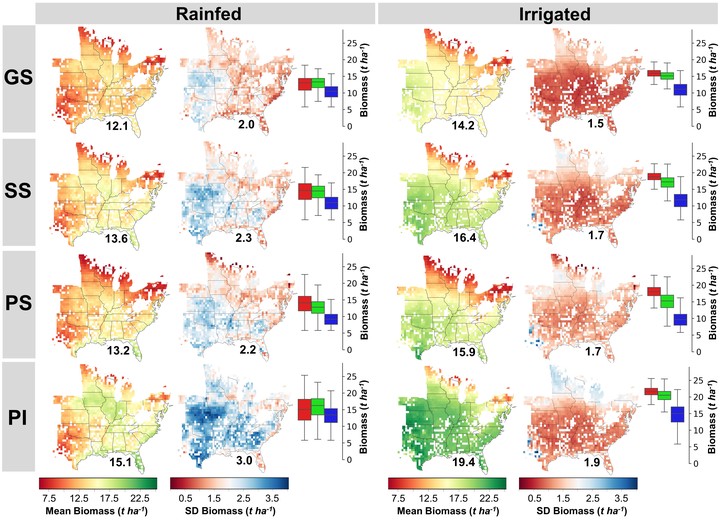Quantifying the effects of varietal types × management on the spatial variability of sorghum biomass across US environments

Abstract
Regional scale estimations of sorghum biomass production allow identification of optimum genotype × environment × management (G×E×M) combinations for bioenergy generation. The objective of this study was to determine the degree of contributions of G, E and M toward variability in sorghum biomass in the USA. Using the Agricultural Production Systems sIMulator in a grid computing platform, biomass was simulated for irrigated and rainfed conditions for 30 years across the USA for four sorghum varietal types (grain-GS, sudangrass-SS, photosensitive-PS and photo insensitive-PI). Simulated biomass was assessed by environments clustered using the sum of intercepted solar radiation (ir), mean of temperature stress factor (tp) and water stress factor (sw). Simulated biomass ranged from 5.8 t ha-1 (GS-rainfed) to 27.5 t ha-1 (PI-irrigated). Under high-temperature environments (mean annual temperature=25°C), rainfed biomass between 40 and 80 days after planting (DAP) was strongly correlated with sw (r=0.64-0.86) and irrigated biomass with ir (r=0.68-0.81). Under low-temperature environments (mean annual temperature=18°C) after 40DAP, tp and ir had greater effects than sw (r=0.55-0.82). Biomass variance was mainly explained by varietal type (50-76%) in all environments × irrigation combinations, except in the high- and mid-temperature environments under rainfed conditions where rainfall had the major effect (25-45%). However, when mean temperature during the growing season decreased from 25°C (high-environments) to 18°C (low-environments), the contribution of mean temperature to biomass variance increased from 7% to 34% (rainfed) and from 4% to 36% (irrigated). Varietal type had the larger interactions with other factors independently of the environment and irrigation. We demonstrated a need to quantify (i) the main G×E×M drivers of biomass variability based on environmental stress factors and (ii) the variance contribution of these drivers on sorghum biomass. Our regional-scale estimations are key inputs for future robust biomass projections of energy sorghum genotypes integrating G×E×M under climate change scenarios.